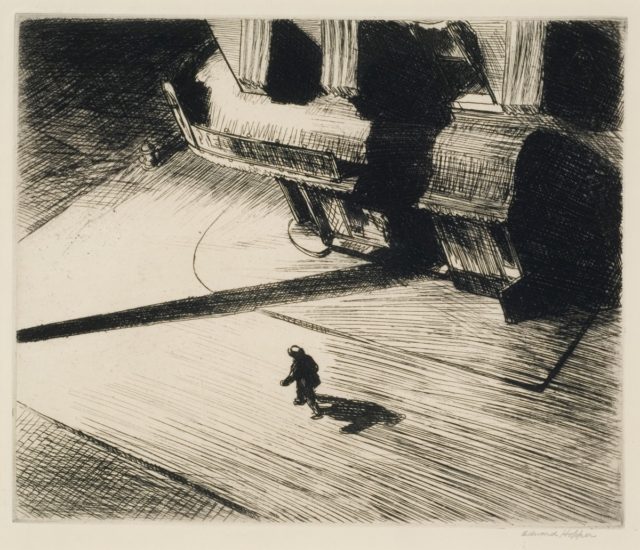Edward Hopper (American, 1882-1967)
Night Shadows, 1921
Etching
Regarding the lack of communication between the people in his paintings, Hopper explains “It’s probably a reflection of my own, if I must say, loneliness. I don’t know. It could be the whole human condition.” [1]
Loneliness shadowed Edward Hopper and was a visibly present theme throughout his artistic career. Night Shadows is a bird’s eye view of solitude, thematically similar to Nighthawks (probably his most recognizable and representative oil painting), but created twenty years prior.
Hopper began a concentration in printmaking in 1915 which lasted until 1923. The date of this work is revealing: America had just started recovering from World War I. Hopper did not necessarily want his work to be contextualized by the chaos around him, but, as we have been experiencing firsthand through the COVID-19 pandemic, induced loneliness has a way of unapologetically pervading daily life.
Hopper is known for strong diagonals and unpredictable points of view. In Night Shadows, Hopper positions the viewer to look down on the street, probably from a window, placing the lone figure on the street corner at a distance. The prominent diagonal shadow obscures our view and blocks us from seeing what the single, lone figure is walking toward. But, in the fleeting moment before he disappears from our view, we get to speculate. Hopper creates a high drama scene that seems to beg for a caption, opening up his work to interpretative storytelling.
This print was made 100 years ago, but the street scene could easily have been rendered today. Seeing streets once full of people become completely barren was disheartening, but there is comfort in the repetitive nature of history. Hopper may be reminding us that this loneliness is temporary.
Hopper lived from 1882-1967 and worked as a painter, engraver, draughtsman, and illustrator. He was an apprentice at the New York School of Art from 1900-1906, where he was taught by Robert Henri (another artist with work in the college’s collection). He went on to travel to Europe where he expanded his understanding of Impressionism. His work has been featured in countless exhibitions including ones at Tate Modern, London; Whitney Museum of American Art, New York; Museum of Fine Arts Boston; the National Gallery of Art, Washington, DC; the Art Institute of Chicago; and the Grand Palais, Paris.
[1] “Edward Hopper Quote.” Lib Quotes, libquotes.com/edward-hopper/quote/lbu7p5x.
–Molly Smith ’24

